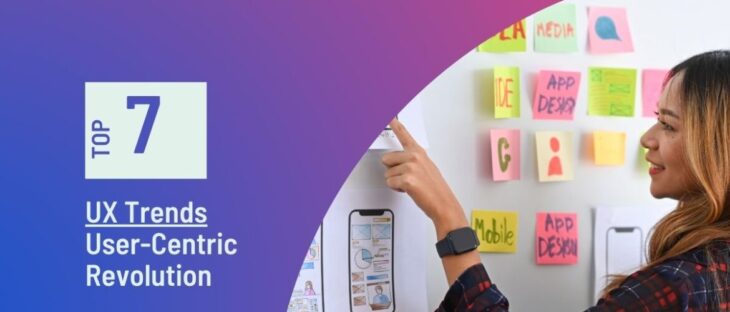
- April 8 2024
- admin
We live in an age where digital experiences shape everything. Today’s consumers have high expectations for intuitive, engaging interfaces across devices and platforms. At the same time, new technologies continually emerge to further enhance user experiences. For UX designers and product developers, it’s vital to understand the latest UX trends to create world-class experiences.
In this deep dive, we will explore the user experience (UX) trends rising to prominence in 2024. By examining what’s new and next in UX trends, organizations can make informed design decisions to delight customers. Let’s dive into the leading-edge UX trends that are redefining digital experiences across industries.
Trend 1: AI-Powered Personalization
Greater personalization continues dominating UX trends, with AI advancing capabilities. Machine learning crunches user data to serve up tailored content, product recommendations, and customized journeys. For example, AI bots engage website visitors based on their interests and behavior. Streaming services suggest the perfect playlist or next binge-worthy show.
However, personalization requires balancing relevance with privacy. Ethical use of data is key. When done right, AI-driven personalization makes every touchpoint feel more unique to the individual.
Trend 2: Multi-Sensory Interactions
Beyond visuals, UX trends show that UX is expanding to engage more of our senses through auditory, haptic, and other multi-sensory inputs. Voice UIs like Alexa enable hands-free audio interactions. Haptics recreate touch through vibrations, while spatial audio immerses us. Even augmented reality can enhance sensory experiences.
Multi-sensory UX adds dimensionality that especially resonates on mobile and wearable devices. By tapping our senses, it creates more intuitive and immersive experiences.
Trend 3: No-UI Interactions
On the flip side, innovations in computer vision, voice, and gestural interfaces are also minimizing the need for visual UI screens. No-UI interactions allow users to simply speak requests or use natural motions. Think auto-opening doors, gesture control for TVs, or voice-activated everything.
Reduced reliance on screens lowers friction and makes experiences more convenient. No-UI aligns with larger UX trends of intelligence, automation, and anticipating user needs proactively.
Trend 4: Design for Trust
With technology handling more sensitive tasks, establishing user trust becomes critical. UX design must instill data privacy, security, and responsible AI ethics. Interfaces should convey transparency – how and why algorithms make decisions for personalized recommendations, for example.
Responsible design builds confidence. Signifiers like secure connection cues and data usage notifications are table stakes. But experiences also win trust by always empowering human agency and oversight. This ethos guides cutting-edge UX trends.
Trend 5: Accessible & Inclusive Design
Along with personalization, accessibility, and inclusion remain top UX trend priorities. All users deserve great experiences tailored to their capabilities. AI can help customize UX based on impairment types and assistive tools used. More mainstream apps also now incorporate accessibility from the start.
Inclusive design benefits all. Curb cuts aid wheelchair users but also people with strollers and bags. Similarly, features for disabilities like captions, color contrast, and voice control improve everyone’s experience.
Trend 6: Conversational Interfaces
Conversational UX like chat and voice bots handle an expanding range of tasks through natural dialog. Sophisticated NLP understands varied phrasing around common requests, while proactively guiding users through workflows. The goal is frictionless conversations that meet users’ needs contextually.
With voice assistants permeating homes and phones, conversational interaction is becoming second nature. Chatbots reduce customer effort for common queries. Immersive audio environments like spatial computing also leverage conversational UX.
Trend 7: Interconnected Ecosystems
Users expect seamless handoffs between devices and platforms. Omnichannel UX connects experiences across the web, mobile, voice, wearables, etc. Changing contexts should feel unified, whether you start an activity on desktop and continue on mobile, or have devices work in tandem.
Interconnected ecosystems also enable composable UX where reusable components integrate smoothly across properties. Maintaining consistency and continuity between touchpoints is the new imperative as UX spreads across fragmented landscapes.
The Road Ahead: Key UX Innovations to Watch
UX innovation will accelerate as enabling tech like AI, AR/VR and ambient computing evolves. Immersed environments will heighten sensory engagement. Predictive experiences will anticipate user needs proactively. Conversational and gesture interactions will minimize UI screens. But finding the right balance between automation and human control remains crucial. Keeping experiences intuitive, inclusive, and focused on user goals is the North Star guiding UX trends forward.
Key UX trends to keep top of mind include:
– Personalization powered by responsible AI/ML
– Multi-sensory interactions engaging more human senses
– No-UI and gesture-based interfaces removing friction
– Building user trust through design ethics and transparency
– Accessibility and inclusion create better experiences for all
– Conversational UX with natural language dialog
– Interconnected ecosystems and composable experiences
By deeply understanding users and the contextual factors shaping their needs, UX designers can craft optimal interactions. Leveraging the new possibilities in AI, mixed reality, and ambient computing, the possibilities for revolutionary UX are endless. The UX trends point to more intuitive, immersive, and human-centered experiences that intelligently adapt to each person and situation. With technology advancing exponentially, the future of UX is here. The time is now to brace for impact and direct these forces to uplift how people universally interact with products and digital worlds.
For organizations seeking help navigating the latest UX trends, Upcore Technologies is an invaluable partner. With expertise across interaction design, human factors research, usability testing, and visual design, Upcore stays ahead of the curve on UX innovations. Their user-centric approach and passion for great design ensures they can bring forward-thinking UX visions to life. By partnering with Upcore, companies can confidently build cutting-edge, differentiated digital experiences that customers love.


